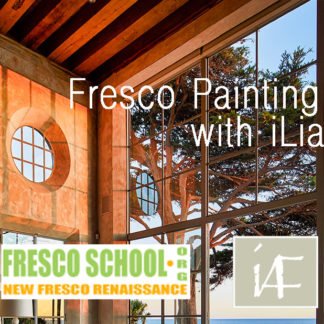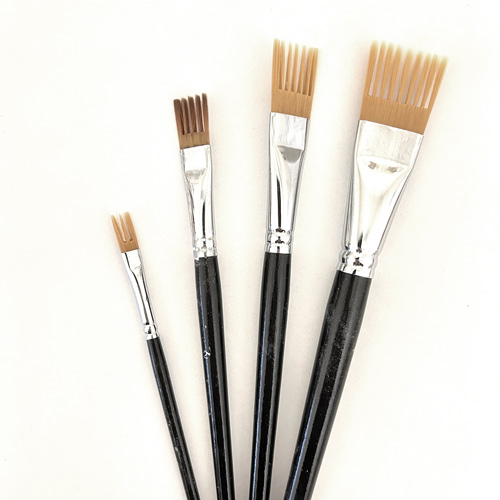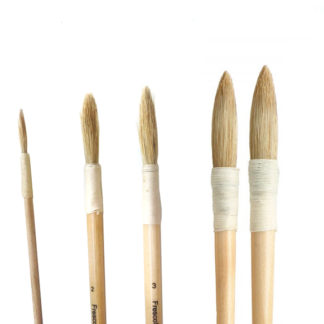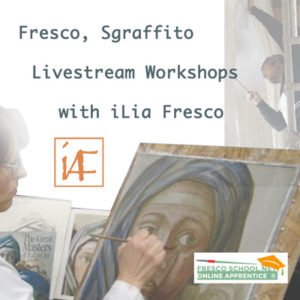The Historic Fresco Pigments are the Natural Earth and Mineral Pigments.
In fresco painting color is mainly representational, tones and shades are highly dependant on the surrounding color and value underpainting. A Historic Fresco Pigments and usual fresco palette is not really limited but minimized for efficiency. In the beginning I would suggest using just a basic set of fresco pigments with 12 or so natural colors such as the list below:
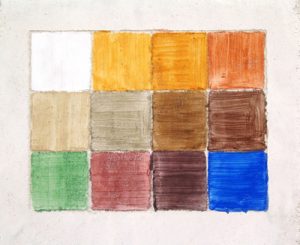
BIANCO DI SAN GIOVANI – is a special kind of lime white pigment first described in literature by Cennino Cennini. Not to be confused with simple chalk, Bianco di San Giovanni, as Cennino Cennini reports, is dried lime which is reduced to powder and then immersed in the water and left to dry in the sun. Therefore Bianco di san Giovanni is calcium carbonate plus calcium hydroxide. Preparation of Bianco San Giovanni is demonstrated in detail in Buon Fresco Foundations: Vol 3 – Pigments & Paint video tutorial by iLia Fresco (Anossov).
YELLOW OCHRE – (clay, ferric oxides) a hydrated iron oxide, also called Gold ochre. Ochres are among the earliest pigments used by people. The name Ochre is of Greek origin, ochres are made from naturally tinted clay containing mineral oxides. It is used as an overall yellow color in fresco painting.
RAW SIENNA – (clay, ferric oxides) a chemical cousin of Ochre, it is of the earliest pigments used by mankind since cave paintings. Name comes from the notable Renaissance mining location near Siena, Italy. Sienna has a slightly darker, reacher reddish/brownish tone than ochre, but not as “red” as red ochre or red iron oxide and not as brown as raw umber. Transparently layered with yellow ochre produces interesting textural tones.
BURNT SIENNA – (clay, ferric oxides) formed by burning raw sienna. A very versatile color, especially for the flesh tones and when a warm red undertone is needed.
WHITE EARTH – (clay, ferric oxides) a delicate light color, used as additive to other colors to produce a softer, “pastel like” paint tones as well as in flesh tones as an alternative to or in combination with “Bianco di San Giovanni” (Lime White). On it’s own white earth is very good for rendering/toning trompe l’oeil plasterwork.
VERDACCIO – (clay, ferric oxides) a dark green semi transparent earth color, a “composite pigment” – the mixture of yellow ochre and black iron oxide or mars black. Verdaccio is a foundational color for the value range development (underpainting). It is neither warm or cold, color tones applied over absorb the value without changing corresponding properties. Often architectural details in frescoes are left in Verdaccio without any additional color layers.
RAW UMBER – (clay, ferric oxides, manganese oxides) a brown color with a various degree of gray – greenish hue. Produces soft and “colder” shadows. In combination with Ultramarine and other Blues (layered and mixed-in) gives soft, grayish more transparent shades of black with lesser contrast then Burnt Umber – Blue combinations.
BURNT UMBER – (clay, ferric oxides, manganese oxides) a dark warm brown color with a degree of “reddish” hue. Produces reach, contrast shadows. In combination with Ultramarine and other Blues (layered and mixed-in) gives deep rather opaque shades of black. Main color for contrast shadow accents, foreground shadow tones and hair.
CHROMIUM OXIDE GREEN – (hydrated chromium oxide, eskolaite) a bright and more opaque green (compared to Terra Verde – Green Earth) of a clear green tone, more vibrant, blueish shade is known as “Viridian”.
RED IRON OXIDE – (iron oxide, hematite) a manmade version of is known as Mars Red. An overall rusty red color as it is transparent washes give cold, purplish hue as opposed to warm reddish undertone of Burnt Sienna. It is used in preparation of flesh tones, mixed with white it gives a cooler pinkish undertone. Traditional Cinabrese (ital) is a “composite pigment”, a mixture of Lime White and Red Iron Oxide. For large frescoes Red Oxide and Red Ochre is also used to create “Sinopia” praparatory painting on the Arriccio (Float Coat) plaster coat.
VIOLET IRON OXIDE – (iron oxide, hematite) a manmade version of Violet Iron Oxide is known as Mars Red (used for this tutorial). A rich dark brownish red with violet undertone, a deep opaque color used as it is as well as for the flesh tones – mixed with white produces violet pinkish tones.
ULTRAMARINE BLUE – (double silicate of aluminum and sodium and sulfates) – a manmade version of natural component of semi-precious stone Lapis Lazuli. Used as blue color as well as, in combination with Raw or Burnt Umbers, to achieve deep black of different shades for shadows
In a summary:
Pigments above are predominantly ferric oxides – https://en.wikipedia.org/wiki/Iron(III)_oxide (different colors might have slightly different formulas, but essentially they are all of the same base – oxides of iron).There are 3 pigments in the set that are different – Chromium Oxide Green;Ultramarine Blue:Bianco San GiovaniLime white – mixture of powder CaCO3 and Ca(OH)₂
This is the base list of fresco pigments , you can have as many pigments of different shades as you want and need for different frescoes, just keep in mind that you always need to simplify your palette for efficiency.
Selection of Fresco Pigments From Cennino Cennini “Craftsman Handbook”
FLESH TINT. Chemical composition: Blend of Earth Pigments.
ORPIMENTO – Orpiment (poisonous)
YELLOW OCHRE. Chemical composition: Terra naturale.
RAW SIENNA – ferric oxide
BURNT SIENNA – ferric oxide
RAW UMBER – ferric oxide, manganese oxides
BURNT UMBER – ferric oxide, manganese oxides
RISALGALLO – Realgar (poisonous)
RED LEAD – Ossido di Piombo
RED BOLE – Blend of Earth Pigments.
VERMILION – Mercury sulphide
CINABRO – Mercury sulphide
AMATISTO – NATURAL RED HEMATITE. Chemical composition: Natural Iron Oxides.
LAPIS AMATITA – Red Jasper Stone – Silicon dioxide
RED OCHRE – Ferric Oxide
VERDERAME – Verdigris, copper carbonate
VERDE AZZURRO – Malachite green
VIRIDIAN – Chromium oxide
VERDACCIO – Blend of Earth Pigments.
AZZURRO OLTREMARINO – Ultramarine Azure from afghan Lapis lazuli
AZURITE BLUE – Copper carbonate
BIADETTO D’OLTREMARE – Ultramarine ashes
VINE BLACK – wood carbon
LAMP BLACK – Residue of carbonization

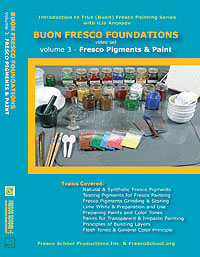 Get Detailed Video Tutorial – BFF V3 – Pigments and Paint.
Get Detailed Video Tutorial – BFF V3 – Pigments and Paint.